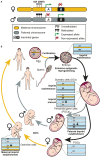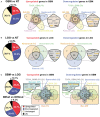Aberrations of Genomic Imprinting in Glioblastoma Formation
- PMID: 33777782
- PMCID: PMC7994891
- DOI: 10.3389/fonc.2021.630482
Aberrations of Genomic Imprinting in Glioblastoma Formation
Abstract
In human glioblastoma (GBM), the presence of a small population of cells with stem cell characteristics, the glioma stem cells (GSCs), has been described. These cells have GBM potential and are responsible for the origin of the tumors. However, whether GSCs originate from normal neural stem cells (NSCs) as a consequence of genetic and epigenetic changes and/or dedifferentiation from somatic cells remains to be investigated. Genomic imprinting is an epigenetic marking process that causes genes to be expressed depending on their parental origin. The dysregulation of the imprinting pattern or the loss of genomic imprinting (LOI) have been described in different tumors including GBM, being one of the earliest and most common events that occurs in human cancers. Here we have gathered the current knowledge of the role of imprinted genes in normal NSCs function and how the imprinting process is altered in human GBM. We also review the changes at particular imprinted loci that might be involved in the development of the tumor. Understanding the mechanistic similarities in the regulation of genomic imprinting between normal NSCs and GBM cells will be helpful to identify molecular players that might be involved in the development of human GBM.
Keywords: genomic imprinting; glioblastoma; methylation; neural stem cells; subventricular zone.
Copyright © 2021 Lozano-Ureña, Jiménez-Villalba, Pinedo-Serrano, Jordán-Pla, Kirstein and Ferrón.
Conflict of interest statement
The authors declare that the research was conducted in the absence of any commercial or financial relationships that could be construed as a potential conflict of interest.
Figures



Similar articles
-
New aspects of glioblastoma multiforme revealed by similarities between neural and glioblastoma stem cells.Cell Biol Toxicol. 2018 Dec;34(6):425-440. doi: 10.1007/s10565-017-9420-y. Epub 2018 Jan 31. Cell Biol Toxicol. 2018. PMID: 29383547 Review.
-
Neural Stem Cells as Potential Glioblastoma Cells of Origin.Life (Basel). 2023 Mar 29;13(4):905. doi: 10.3390/life13040905. Life (Basel). 2023. PMID: 37109434 Free PMC article. Review.
-
Alteration of Genomic Imprinting Status of Human Parthenogenetic Induced Pluripotent Stem Cells during Neural Lineage Differentiation.Int J Stem Cells. 2019 Mar 30;12(1):31-42. doi: 10.15283/ijsc18084. Int J Stem Cells. 2019. PMID: 30836722 Free PMC article.
-
The Subventricular Zone in Glioblastoma: Genesis, Maintenance, and Modeling.Front Oncol. 2022 Mar 10;12:790976. doi: 10.3389/fonc.2022.790976. eCollection 2022. Front Oncol. 2022. PMID: 35359410 Free PMC article. Review.
-
Genomic Imprinting and the Regulation of Postnatal Neurogenesis.Brain Plast. 2017 Nov 9;3(1):89-98. doi: 10.3233/BPL-160041. Brain Plast. 2017. PMID: 29765862 Free PMC article. Review.
Cited by
-
Prognostic Value of MEG3 and Its Correlation With Immune Infiltrates in Gliomas.Front Genet. 2021 Jun 16;12:679097. doi: 10.3389/fgene.2021.679097. eCollection 2021. Front Genet. 2021. PMID: 34220951 Free PMC article.
-
Allelic expression patterns of imprinted and non-imprinted genes in cancer cell lines from multiple histologies.Clin Epigenetics. 2025 May 25;17(1):83. doi: 10.1186/s13148-025-01883-3. Clin Epigenetics. 2025. PMID: 40414875 Free PMC article.
-
Hypomethylation at H19DMR in penile squamous cell carcinoma is not related to HPV infection.Epigenetics. 2024 Dec;19(1):2305081. doi: 10.1080/15592294.2024.2305081. Epub 2024 Jan 21. Epigenetics. 2024. PMID: 38245880 Free PMC article.
-
An update on the molecular biology of glioblastoma, with clinical implications and progress in its treatment.Cancer Commun (Lond). 2022 Nov;42(11):1083-1111. doi: 10.1002/cac2.12361. Epub 2022 Sep 21. Cancer Commun (Lond). 2022. PMID: 36129048 Free PMC article. Review.
-
Genomic Imprinting in the New Omics Era: A Model for Systems-Level Approaches.Front Genet. 2022 Mar 15;13:838534. doi: 10.3389/fgene.2022.838534. eCollection 2022. Front Genet. 2022. PMID: 35368671 Free PMC article. Review.
References
Publication types
LinkOut - more resources
Full Text Sources
Other Literature Sources

